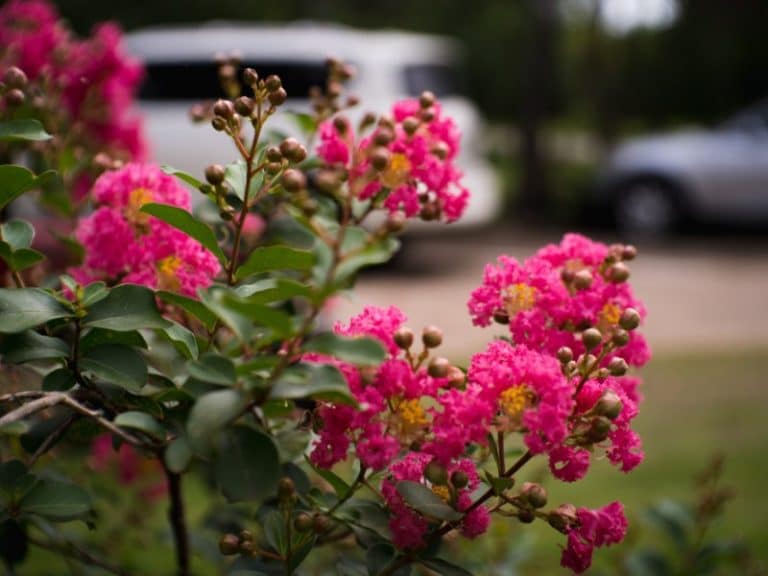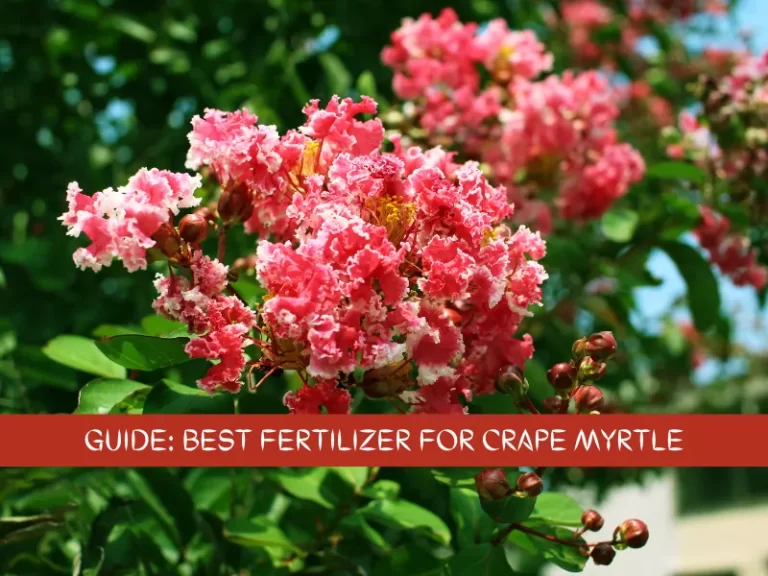7 Awesome Trees with Purple Flowers for Your Yard
Selecting an ideal tree with purple flowers for your yard can be daunting. You’re confused and worried about the small details that might be a deal breaker for your chosen tree. Planting the wrong tree can interfere with your garden’s ecosystem. Worst, the tree might die if growth conditions are unfavorable.
The jacaranda, eastern redbud, purple orchid, vitex Agnus-castus, purple wisteria, and purple lily magnolia are some of the best trees with purple flowers to plant in your yard. Most of these trees bloom starting Spring, making them a great choice for a colorful yard.
6 Trees with Purple Flowers
Depending on your needs, I highly recommend that you look at the root system, height, and growth pattern of trees before selecting them for your yard. A rule of thumb is to select trees with non-invasive roots, a desirable maximum height, and low care requirements.
Here are the top 7 trees with purple blooms that I’d recommend:
1. Jacaranda (mimosifolia)
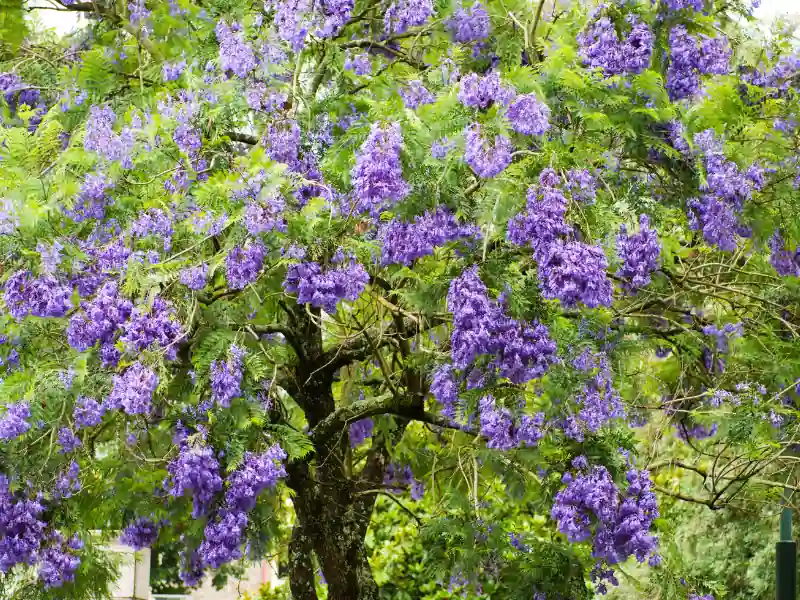
Native to Northwestern Argentina, jacaranda is the most popular tree with purple flowers in the tropics. It has showy, fragranced, lilac-purple flowers that retain their color even after shedding.
The jacaranda tree blooms in April and August. Older trees are 25 to 40 feet tall and 45-60 feet wide. This tree thrives in USDA zones 9-11. Established jacaranda trees thrive in full sun.
Jacaranda trees have an invasive root system, so avoid planting them near driveways or house foundations, as they can damage them.
The jacaranda tree prefers well-draining soils, including sand, clay, and loam. Furthermore, the soil should be slightly alkaline or acidic. Deep, frequent watering is necessary, especially in summer, to encourage dense canopies.
The jacaranda can tolerate drought and alkaline conditions but is susceptible to cold winters.
Prune established jacarandas to remove dead branches through dead wooding. Small trees also require frequent pruning of the side branches that emerge from the main trunk. Prune after every three years from the first pruning and maintain it for 15-20 years.
2. Eastern redbud tree (Cercis Canadensis)
The eastern redbud tree is native to eastern North America and is ideal for small yards because of its short stature. It has pea-shaped clustered flowers with heart-shaped, glossy green leaves that add ambiance to your yard. The tree blooms in early spring before green leaves emerge and throughout the period.
You can shape eastern redbud as you wish. The tree canopy is flat at the top or rounded, and the trunks have reddish or brownish barks that resemble scales. Because of its deep tap root system, propagation is through planting smaller trees.
Small trees grow fast, while older ones grow at a moderate rate. A mature tree is 20-30 feet tall and 25-35 feet wide.
Eastern redbud trees are hardy in the USDA zones 4-9 and thrive under full sun. The soil must be acidic or slightly alkaline and well-draining. Although it tolerates drought, regular watering is essential, especially in summer.
The tree resists pests and disease, although mushroom rot can be common in poorly drained soil.
3. Purple orchid tree (Bauhinia variegata)
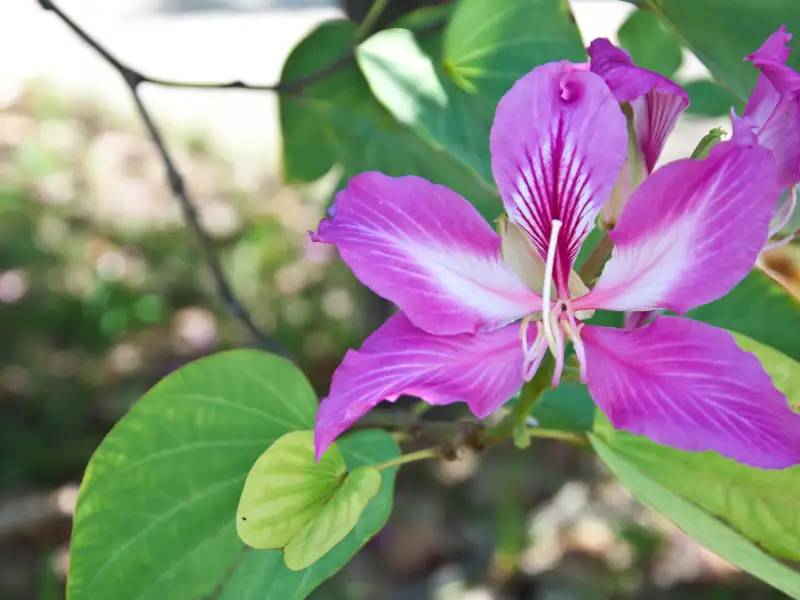
The purple orchid tree is native to China and India. It has fragranced, large, showy purple flowers resembling an orchid. The vibrant purple flowers bloom from September to November. Blooming occurs twice – in fall before the leaves drop and in winter.
Purple orchid trees grow fast to 35 feet tall and can spread the same width. The plant is hardy in the USDA zones 9-11 and thrives in full sun or partial shade. Propagation is through stem cuttings, seeds, or out layering.
The soil must be acidic or slightly alkaline and well-draining. Older trees need deep watering every ten days during hotter months. The purple orchid tree moderately tolerates salt but highly resists drought.
Pruning is necessary to remove dead branches, but fertilization is unnecessary. Although pests and diseases are uncommon, purple orchids can suffer leaf spots and scorch in the drier months. Mites, caterpillars, and bore are the most common pests on this tree.
4. Vitex agnus-castus
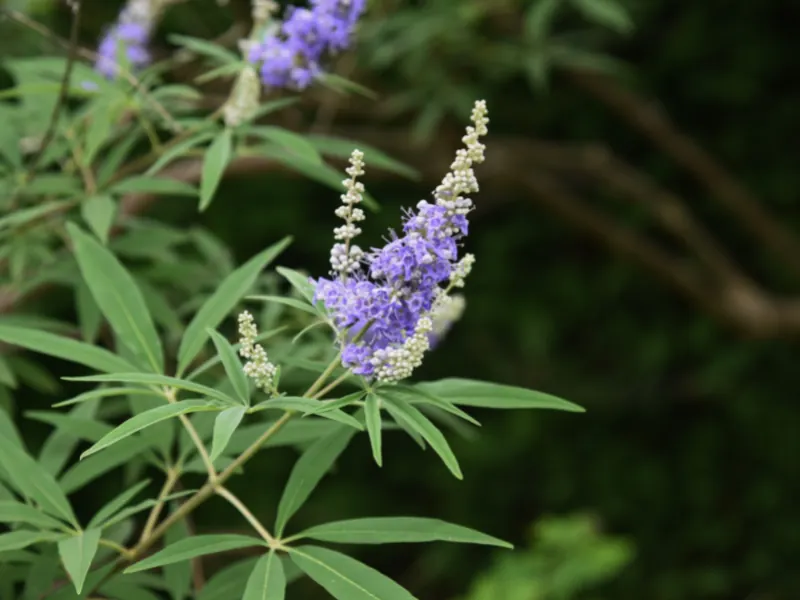
Vitex agnus-castus tree is commonly known as Monk’s pepper, chaste berry, chaste tree, lilac chaste tree, or texas lilac. It originates from Pakistan and the Mediterranean and is a tree or shrub.
As a small tree, the plant grows straight and appears rounded at the top, while shrubs resemble a vase. An established chaste tree grows 3-20 feet tall and 3-15 feet wide.
The vibrant, showy, fragranced purple or lavender flowers bloom in spring and summer. The chaste tree is hardy in USDA zones 7-8. Propagation is by seeds. Since it loves hot weather, the chaste tree prefers full sun exposure for at least 6 hours daily. Besides, the full sun encourages optimal blooming.
Sand, loam, and clay are the best soils to grow the chaste tree. However, the soil must be moist with good drainage.
The chaste tree is resistant to drought, heat, salt, insects, deer, and dry soils. However, weeds are a common problem. An established tree doesn’t need watering. Fertilization should be done once or twice per year. Pruning is essential to remove dead branches. Deadheading also encourages production.
5. Purple Wisteria (Wisteria frutescens)
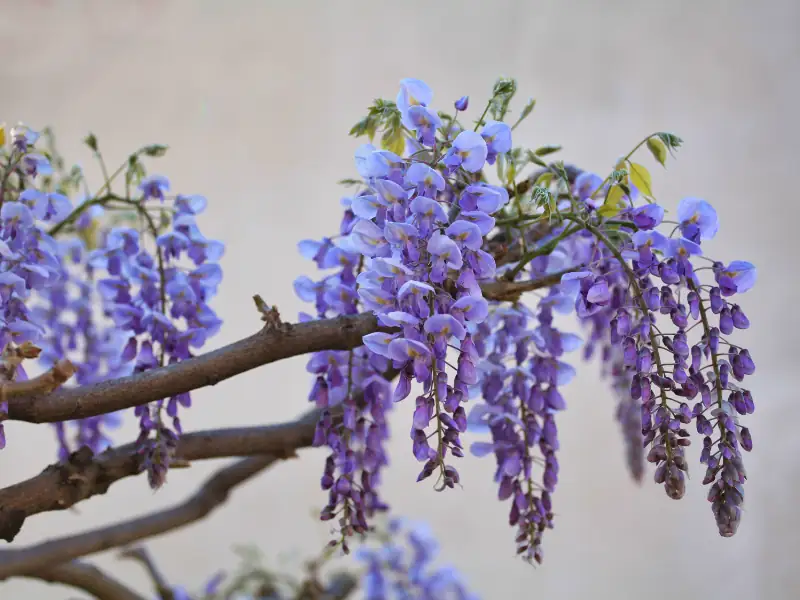
Native to China, the Wisteria is a deciduous woody vine that climbs on other trees for survival. This tree has showy, scented, pea-like, purple flowers that bloom before leaves emerge but stop before they fully drop. Blooming is from April to May and sometimes shortly in summer.
The purple wisteria is hardy in USDA zones 5-9 and propagates by seeds or stem cuttings. It grows rapidly; a mature tree is 15 feet tall and 4 feet wide.
A purple wisteria needs full sun of up to 6 hours daily to thrive. Partial shade might work, although the exposure should be 2-6 hours.
The soil should be well draining and slightly acidic. Loam, clay, or soil with high organic matter is perfect. Purple wisteria tolerates drought, heat, and soil compaction.
Purple wisteria is an excellent addition to yards prone to deer attacks. The plant is resistant to deer and keeps them away. Concurrently, purple wisteria is great for attracting bees and butterflies. The plant is mildly toxic to humans and pets.
6. Purple lily magnolia
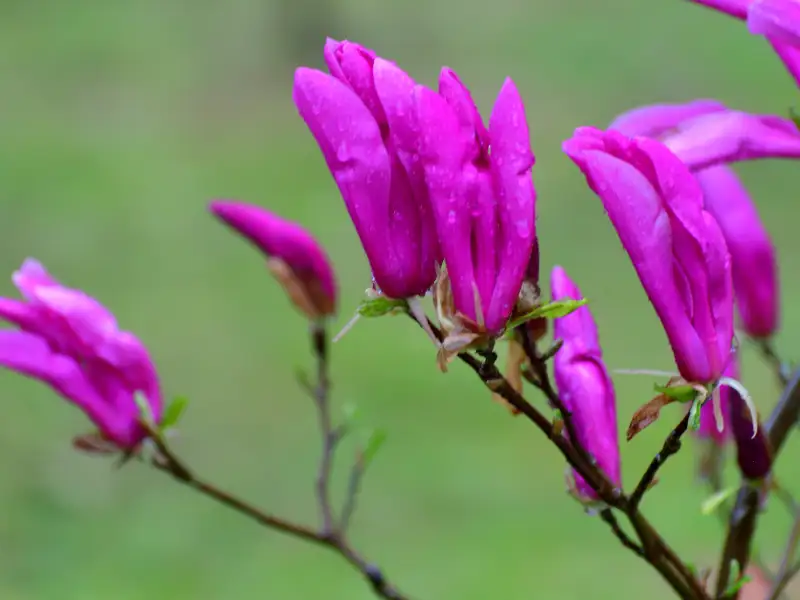
Purple lily magnolia is a small woody tree or deciduous shrub native to china. The plant exhibits showy, fragrant purple flowers that bloom before the leaves open in spring and summer – April to May.
The tree grows slowly and has multiple branches along the main stem. An established purple lily is about 8 feet tall and 8 feet wide but appears rounded at the top.
The purple lily magnolia is hardy in USDA zones 5-8. Propagation is through stem cuttings. The soil must be neutral or slightly acidic, moist, and well-draining. The plant prefers full sun exposure of at least six hours or partial shade of 2-6 hours.
Purple lily’s resistance to drought, insects, and disease is impressive. However, it can suffer from leaf spots, powdery mildew, honey fungus, and gray mold. Insects such as capsid bugs and snails are common to this tree.
This tree requires low watering, usually when the top few inches of soil are dry. Younger or newly planted ones must be watered, while mature plants need watering in the dry months.
Light pruning is necessary for late summer or spring after blooming. Prune younger trees lightly to remove dead and overextending branches. Purple lily magnolia needs little fertilization, especially in spring when the plant develops new leaves.
7. Lilac trees

There are lilac trees and lilac shrubs. Here, I’m recommending lilac trees, which have fewer stems and branches than bushes.
Lilac, popularly known as Common Lilac of the Oleaceae family, originated from the Balkan Peninsula.
The lilac tree is a small multi-stemmed tree that grows approximately 20-25 feet tall.
It is a very popular, eye-catching plant in yards, parks, and even gardens, because of its attractive, sweet-smelling purple blooms. The fragrant flowers bloom in early summer before the blossoming of other trees.
Conclusion
You can add ambiance to your yard by planting trees with fragranced, colored flowers. From the famous jacaranda tree to the purple lily magnolia tree, you have many trees to choose from.
However, be more careful when selecting a tree with purple flowers for your yard. Otherwise, your tree might die or fail to bloom because of unfavorable growth conditions.
The most critical factors to consider are your location (USDA zone), availability of sun or shade, water needs, blooming period, and the level of care a potential tree needs. Match these elements to the growing conditions in your yard before settling for a tree.
References
- North Carolina State Extension: Magnolia liliiflora.
- PennState Extension: Eastern Redbud: A Superb Tree for Almost Any Landscape.
- University of Florida: Jacaranda mimosifolia.


